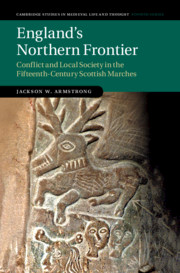Book contents
- England’s Northern Frontier
- Cambridge Studies in Medieval Life and Thought
- England’s Northern Frontier
- Copyright page
- Dedication
- Contents
- Figures
- Maps
- Acknowledgements
- Abbreviations
- 1 Introduction
- Part I
- Part II
- Part III
- 6 The Administration of Justice
- 7 Patterns of Conflict
- 8 Cross-Border Conflict
- 9 Discord
- 10 Concord
- 11 Conclusions
- Bibliography
- Index
11 - Conclusions
from Part III
Published online by Cambridge University Press: 30 October 2020
- England’s Northern Frontier
- Cambridge Studies in Medieval Life and Thought
- England’s Northern Frontier
- Copyright page
- Dedication
- Contents
- Figures
- Maps
- Acknowledgements
- Abbreviations
- 1 Introduction
- Part I
- Part II
- Part III
- 6 The Administration of Justice
- 7 Patterns of Conflict
- 8 Cross-Border Conflict
- 9 Discord
- 10 Concord
- 11 Conclusions
- Bibliography
- Index
Summary
This book has examined the English far north largely through the prism of conflict and its management. The region presents some remarkable patterns of local conflict and social organisation, and indeed in many ways appears exceptional given what is known about the rest of England. However, the region’s reputation for being an exception oversimplifies matters to the point of distortion. In terms of landscape and settlement, the area reveals significant variation, and any attempt to treat those features as if they described an exclusively upland, pastoral environment devoted to livestock rearing must be avoided. Regarding elite architecture, there too is much variation, and the tower ‘style’ of the region cannot be understood solely as a response to military pressure of the frontier. The frontier itself must be appreciated in terms of both rhetoric and reality. The rhetoric of peril was a useful political tool; in reality, the marches of the frontier formed an outward-facing gateway for the kingdom, well integrated with the rest of the realm in all senses governmentally, and also legally and diplomatically integrated with the counterpart marches of Scotland. Real peril was experienced from time to time, but not as an omnipresent threat.
- Type
- Chapter
- Information
- England's Northern FrontierConflict and Local Society in the Fifteenth-Century Scottish Marches, pp. 337 - 345Publisher: Cambridge University PressPrint publication year: 2020

